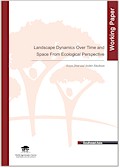| Working Paper Series |
 |
|
| Title | Landscape dynamics over time and space from ecological perspective | | Author | Sonya Dewi and Andree Ekadinata | | Year | 2010 | | Publisher | World Agroforestry Centre - ICRAF, SEA Regional Office | | City of Publication | Bogor, Indonesia | | Series Number | Working paper no 103 | | Number of Pages | 74 | | Call Number | WP0135-11 | | Keywords | Landscape composition, configuration, matrix, connectivity, fragmentation, drivers of land
use changes, multifunctional landscapes |
|
| Abstract: |
Land use and land cover changes driven by multiple factors have tremendous impact on
environmental services as well as livelihoods and economic development of people living in the landscapes and external to the landscapes. In particular for biodiversity, landscape configuration is at the very least as important as landscape composition by increasing fragmentation and reducing connectivity of habitat. Protected areas are necessary but not sufficient in maintaining biodiversity at the landscape level for several reasons: (i) management and enforcement are often weak, (ii) protected areas are often delineated in remote, rough terrain areas which does not represent various ecoregions with various species assemblages and endemism, (iii) the extent of protected areas sometimes are not large enough to allow minimum viable population such that in the long run species extinction might continue to happen, (iv) protected areas without buffer zones and corridors can easily be isolated areas rather than integral part of a landscape. Multifunctional landscapes that accommodate conservation and development need to be considered as an integrated, rather than segregation, systems; this will allow us to achieve the objective of maintaining biodiversity at the landscape level. Land use plan that aims to increase multifunctionality of landscapes should be informed by the current status of landscape composition and configuration, process of land use/cover changes in the past and future, areas that are vulnerable to changes in the future and options for intervention. The land use planning process should be conducted within a negotiation process among multiple stakeholders. This work provides some results to be used as a basis for negotiation, which are produced from the combination of tools from remote sensing, GIS and spatial analysis guided by ecological principles. The results provide data for further research as well as suggest follow-up research questions.
These analysis of five landscapes (Bungo in Indonesia, Viengkham in Laos, Manompana in Madagascar, Takamanda-Mone in Cameroon and East Usambara in Tanzania) using the same methodology and tool allows comparisons across sites. Deforestation rates and land use/cover changes across landscapes along with land use/cover changes are used to define the stage of forest transition; Takamanda-Mone, Viengkham, Manompana, East Usambara and Bungo is the ordered list from earliest to advanced stages. Spatial pattern of deforestation, depending on landscape topography, level of accessibilities and state of forest transition, either are concentrated in relatively flat areas in the landscape, follow encroachment pattern of primary forest block, along the transportation network, or expansion of existing settlement. Combining these spatial patterns of deforestation with changes in landscape configuration, especially at sub-landscape level (quantified by selected indices), we can identify vulnerable areas in the future such that options to reduce risks can be discussed and negotiated within land use planning processes. |
|